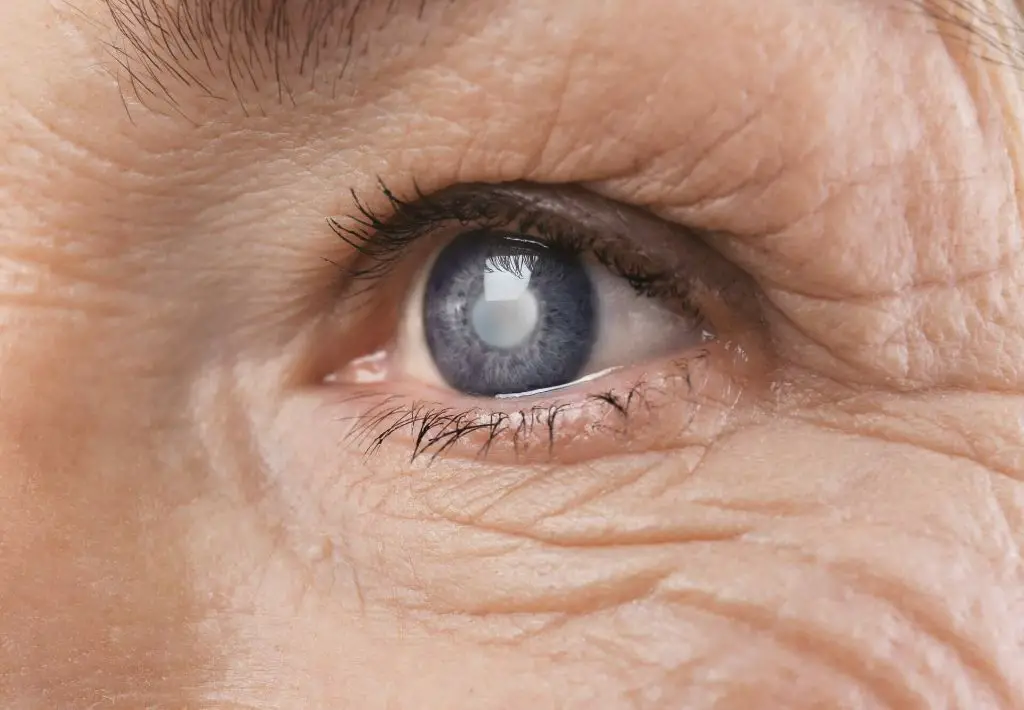What is a cataract?
A cataract is a clouding of the natural lens in the eye that affects vision. The lens is normally clear and transparent, but when a cataract develops, the lens becomes cloudy and opaque. This prevents light from easily passing through the lens, causing blurred vision (https://www.mayoclinic.org/diseases-conditions/cataracts/symptoms-causes/syc-20353790).
As a cataract grows and becomes denser, it scatters more light entering the eye. This scattering causes hazy and double vision. Colors start to look faded, and affected individuals may experience increased sensitivity to glare from lights. Night vision also becomes impaired as cataracts progress. The clouding develops slowly in most cases, with vision worsening over time. Cataracts typically affect both eyes, but may progress faster in one eye (https://www.mayoclinic.org/diseases-conditions/cataracts/symptoms-causes/syc-20353790).
Although the underlying mechanism is not fully understood, a cataract forms when there are changes to the protein structure of the lens. The lens is made mostly of water and protein. As protein fibers in the lens break down or clump together, they start to cloud a small area of the lens. Over time, the clouded areas enlarge and spread, interfering with more of the light entering the eye.
Who gets cataracts?
Cataracts typically affect older adults. According to the National Eye Institute (NEI), by age 80, more than half of all Americans either have a cataract or have had cataract surgery.1 The risk of cataracts increases as you get older. Some studies show that after age 40, the prevalence of cataracts doubles every 10 years.2
There are also certain factors that increase the risk of developing cataracts at a younger age, including:3
- Ultraviolet radiation exposure
- Smoking
- Obesity
- Diabetes
- Previous eye injury or inflammation
Cataracts can occur in one or both eyes. Some studies show women are more likely to develop cataracts due to increased life expectancy.4 However, there are no significant differences in cataract prevalence across racial or ethnic groups.
How is cataract surgery performed?

Cataract surgery is typically performed as an outpatient procedure and takes less than an hour to complete. The basic steps of the procedure are:
Anesthesia: The eye is numbed with either topical anesthetic eyedrops or local anesthesia around the eye. Many cataract surgeries are performed under topical anesthesia alone, without the need for needles.
Opening the eye: The surgeon makes a tiny incision in the cornea to access the lens. The incision is usually less than 3 mm long.
Removing the lens: Using microsurgical instruments, the cloudy natural lens is broken apart with ultrasound and suctioned out of the eye.
Inserting the new lens: The surgeon folds and inserts an artificial intraocular lens (IOL) into the empty lens capsule. The IOL will permanently replace the natural lens.
Closing the incision: The corneal incision is closed with minute absorbable stitches or allowed to seal on its own.
After surgery, patients can usually go home within a few hours. Complete recovery takes about 4-6 weeks. Vision gradually improves during the healing process as swelling subsides.[1]
What are the benefits of cataract surgery?
The main benefit of cataract surgery is improved vision. According to the American Academy of Ophthalmology, over 90% of people who undergo cataract surgery report better vision afterwards (source). With the clouded natural lens removed, patients can see colors more vividly, read small print, and perform activities like driving and reading with ease.
Beyond better eyesight, cataract surgery can also significantly improve quality of life. A cataract clouds vision and makes everyday tasks more difficult. Cataract removal can help seniors maintain their independence by allowing them to cook, clean, manage medications, and get around safely. The surgery can also reduce the risk of falls and accidents.
Many patients report improvements in their overall well-being after cataract surgery. With crisper vision and restored ability to pursue hobbies like reading and arts, patients often experience boosted mood, confidence, and engagement with loved ones (source). The benefits of cataract surgery extend far beyond the eye itself.
What are the risks of cataract surgery?
Like any surgery, cataract surgery carries some risks. Some of the main risks include:
Infection – There is a small risk of eye infection after surgery. This is usually treated with antibiotic eye drops. In rare cases, a serious infection inside the eye (endophthalmitis) can cause permanent vision loss if not treated promptly (1).
Bleeding – Bleeding inside the eye during surgery is rare but can cause vision loss. Using anesthesia and controlling blood pressure during surgery helps minimize this risk (2).
Retinal detachment – In some cases, the retina can become detached during cataract surgery, causing significant vision impairment if not fixed with additional surgery. The risk is low, around 0.5% (3).
Loss of vision – There is a small chance of permanent vision loss due to complications from infection, bleeding or retinal detachment. With appropriate pre-op testing and an experienced surgeon, the risk is very low at less than 1% (1).
Proper precautions during surgery, post-op care, and follow-up with an ophthalmologist can help detect and treat any complications early.
(1) https://www.mayoclinic.org/tests-procedures/cataract-surgery/about/pac-20384765
(2) https://eyewiki.aao.org/Cataract_Surgery_Complications
(3) https://www.aao.org/eye-health/diseases/what-is-cataract-surgery
How much does cataract surgery cost?
The cost of cataract surgery can vary depending on the type of procedure, the surgeon, and whether you have health insurance. According to the American Academy of Ophthalmology, the average out-of-pocket cost for routine cataract surgery is around $3,600 per eye when paying without insurance in the United States.

With health insurance, out-of-pocket costs are often substantially lower. Original Medicare covers a portion of standard cataract surgery, with the average Medicare patient paying around $233 per eye. With supplemental Medigap insurance, some of the coinsurance costs can also be covered. Those with private insurance can expect variable costs depending on their plan’s coverage and copays.
The cost using laser cataract surgery or advanced lens implants may range from $4,000-$6,000 per eye without insurance. Factors like the surgeon’s fees, type of facility, and additional tests can also impact surgical costs. Overall, while expensive without insurance, basic cataract surgery is often covered to a large extent by Medicare and private insurance.
What is the success rate of cataract surgery?
Cataract surgery has a very high success rate. According to the National Center for Biotechnology Information, while as many as 95% of patients will have improved visual acuity, cataract surgery does have complications (source). However, most studies show that around 98% of patients have significantly improved vision after cataract surgery.

A study in the Journal of Cataract & Refractive Surgery analyzed data from more than 4000 cataract surgeries and found that 98% achieved a postoperative best corrected visual acuity of 20/40 or better (20/40 is considered the threshold for legal driving vision). 75% achieved 20/25 vision or better.
Another study in Clinical Ophthalmology looked at 53,000 cataract surgeries and found that 99% resulted in improved visual acuity. The risk of complications was low, with most being treatable. The study concluded that with proper patient selection, technique and close postoperative care, success and safety are now the rule in cataract surgery, not the exception.
While serious complications can occur in a small percentage of cases, the vast majority of cataract surgeries successfully restore vision, with over 90% of patients achieving 20/40 vision or better. Advances in technology and surgical techniques have made cataract surgery one of the most reliably successful operations in all of medicine.
When is the optimal time for cataract surgery?
There is no universally agreed upon threshold for when cataract surgery should be performed. According to the American Academy of Ophthalmology, the decision of when to have surgery is a personal one that patients should make with their eye doctor. Some general guidelines on optimal timing include:
Surgery is typically recommended when cataracts begin to impair important daily activities such as reading, driving, watching TV, and recognizing faces. According to the Mayo Clinic, cataract surgery is generally recommended when cataracts worsen vision or interfere with treatment of other eye conditions.
Many ophthalmologists recommend cataract surgery when vision drops below 20/40 in one or both eyes. However, some patients may choose to undergo surgery earlier if they desire improvement in visual symptoms like glare and halos.
Some ophthalmologists use cataract grading scales to help determine surgical timing. One common scale is the LOCS III which classifies cataracts from 1 (mild) to 5 (severe). Cataracts graded 3-5 typically cause significant visual impairments that warrant surgery.
In general, the optimal time for cataract surgery is when the functional and visual impacts of the cataract begin interfering with a patient’s quality of life and activities.
Are there alternatives to surgery?
While cataract surgery is the only definitive treatment to restore vision loss from cataracts, there are some non-surgical alternatives that can help manage symptoms, especially in early stages. However, these options will not cure cataracts or stop their progression over time.
Glasses: New prescription eyeglasses, bifocals, or magnifying glasses can help improve vision when cataracts first start to develop. As the cataract worsens, stronger lenses or brighter lighting may be needed to maintain visual acuity.
Medications: Currently, no medications can reverse or remove cataracts. However, anti-inflammatory eye drops may temporarily relieve swelling and improve vision for a short time. Steroid eye drops are sometimes prescribed, but long-term use can increase eye pressure or cause cataracts to progress faster.
Lifestyle changes: Quitting smoking, wearing sunglasses and a brimmed hat outdoors, eating a healthy diet rich in antioxidants, and controlling other medical conditions like diabetes may help slow the progression of cataracts. But these strategies cannot cure or eliminate cataracts.
While helpful at first, these non-surgical approaches have limited effectiveness as cataracts advance. Most patients with visually significant cataracts will eventually need surgery for the best visual outcomes.
The bottom line: Is basic cataract surgery worth it?
In summary, the benefits of cataract surgery generally outweigh the risks for most patients. Cataract surgery is considered a safe procedure with a high success rate of over 98% (https://practiceplusgroup.com/knowledge-hub/risks-benefits-cataract-surgery/). The surgery reliably improves vision in patients suffering from cataracts and can be life-changing, allowing them to regain independence and resume activities impacted by vision loss.
However, as with any surgery, there are some risks to consider such as infection, bleeding, swelling, and other rare complications. The surgery itself and recovery process can also be difficult for some patients. There is also a small chance of the cataract returning after surgery. Some ophthalmologists recommend waiting to have cataract surgery until the cataracts mature and vision loss impacts daily living (https://www.bswhealth.com/blog/how-safe-is-cataract-surgery).
Overall, for otherwise healthy patients with cataracts causing functional vision impairment in daily life, cataract surgery is usually recommended and worth the benefits for most people. Patients should discuss the pros and cons with their eye doctor to determine the right time for surgery based on their individual circumstances. But in general, cataract surgery is a safe, effective procedure that can substantially improve vision and quality of life.


